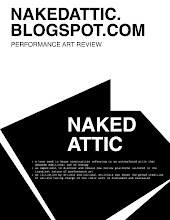
William Kentridge, ‘I AM NOT ME, THE HORSE IS NOT MINE’
Part lit. 102 ‘Russian Authors’, part manifesto, part mission statement, part midnight rambling, part literary history of the fragmented self, part didactic lecture, part comedy routine, part fragments of other parts. . .
. . . it begins as a lecture. Kentridge is on stage describing for us his research into Nicolai Gogol’s short story ‘The Nose’ for an upcoming opera ‘The Nose’ by Shostakovich. He’s an enthusiastic college professor, energized by the profundity of his subject: the fragmented self in the western cannon. He reads aloud from the text, pince-nez on, pince-nez off, on and off, off and on, the artist’s handsome prodigious nose. That nose! Then, of course, Gogol’s nose in the story is gone, off on a career of its own and we follow it, and as we do, Kentridge appears on the stage in the projection behind him. He’s in the Kentridge uniform, his own Chaplin bowler/Beuys vest: white shirt and black pants. The doubled self is pathetic, shuffles on stage, shoulders slumped, trying to hide, a bum, a clown; he’s channeling Kentridge’s failure, the possibility that nothing will align, no point of meaning arrive. He listens, bored, as Kentridge delves deeper into the history of the fragmented self: from Gogol, to Cervantes to Tristam Shandy, self divided against self, stories within stories.
Kentridge lectures on our capacity to make bits of paper into form. The projection becomes hands forming a horse of torn paper: it’s the horse in Cervantes, the horse in the title that appears. It starts with 10 pieces of paper for the horse, then 6 then 3: the limit of our capacity to hold it is reached. Overextended, it becomes paper again. The papers fall off the page and the pathetic double dodges them. He gathers Kentridge’s dropped papers and hurls them in the air, collects them in reverse order. Later he falls asleep on a chair and then he sneaks away silently.
 We proceed through a series of fragment and vignettes as Kentridge circles for meaning within the larger project of forming the Opera. He’s kept awake at night in bed (he appears in the projection with his wife sleeping soundly beside him at 4 am) trying to make meaning out of the bits and pieces he’s presented with. He’s searching for parallels with Gogol’s story: ‘Trotsky is the Nose separated from the party . . . no no’ he says, followed by, ‘The Nose is Persephone in the Labyrinth. . .’ and then cruelly berates himself for forgetting his Greek myths. The sleeplessness devolves into a chaos of images, the Nose is diving into a pool over and over again, the Nose appears in a processional, the processional runs mad, flags torn apart, its hands and then puppets and people, Russian avant-garde posters and text.
We proceed through a series of fragment and vignettes as Kentridge circles for meaning within the larger project of forming the Opera. He’s kept awake at night in bed (he appears in the projection with his wife sleeping soundly beside him at 4 am) trying to make meaning out of the bits and pieces he’s presented with. He’s searching for parallels with Gogol’s story: ‘Trotsky is the Nose separated from the party . . . no no’ he says, followed by, ‘The Nose is Persephone in the Labyrinth. . .’ and then cruelly berates himself for forgetting his Greek myths. The sleeplessness devolves into a chaos of images, the Nose is diving into a pool over and over again, the Nose appears in a processional, the processional runs mad, flags torn apart, its hands and then puppets and people, Russian avant-garde posters and text.Towards the end, Stalin’s tribunal meets and a man is on trial: Kentridge reads the text from his ladder while his doppelganger falls asleep behind him: it’s a desperate plea to be allowed to die of his illness, that his crimes against the party don’t warrant the punishment, he’s too weak to speak, and at the end of each short sentence/plea to the tribunal Kentridge reads: ‘in brackets, general laughter in the room.’ Twin telephone cables hum in a gale; it’s the self outside, a tribunal against the self, a utopian impulse that mocks human frailty. The bum sneaks off stage.
This storm of cross-pollinating fecundity is married to Kentridge’s ghost and oldest bugaboo – Felix and Soho – self divided from self. The real Kentridge (we presume) on stage is
 desperately searching for a whole to draw all these figures into. In its best moments we don’t need the 10 fragments, 6 will make the metaphor hum and even when there are only 3 and the bum/clown is right and the center can’t hold, when the horse disappears – even then, we are left holding the impulse, the desire to see a whole. That alone is worth the price of admission.
desperately searching for a whole to draw all these figures into. In its best moments we don’t need the 10 fragments, 6 will make the metaphor hum and even when there are only 3 and the bum/clown is right and the center can’t hold, when the horse disappears – even then, we are left holding the impulse, the desire to see a whole. That alone is worth the price of admission.
.jpg)
No comments:
Post a Comment